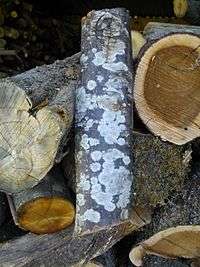Ostrya carpinifolia
| European hop-hornbeam | |
|---|---|
| | |
| Scientific classification | |
| Kingdom: | Plantae |
| (unranked): | Angiosperms |
| (unranked): | Eudicots |
| (unranked): | Rosids |
| Order: | Fagales |
| Family: | Betulaceae |
| Genus: | Ostrya |
| Species: | O.carpinifolia |
| Binomial name | |
| Ostrya carpinifolia Scop. | |
 | |
| Native range | |
Ostrya carpinifolia, the European hop-hornbeam, is a tree in the family Betulaceae. It is the only species of the genus Ostrya that is native to Europe.
Distribution

Ostrya carpinifolia is found in Italy, France, Austria, Slovenia, Albania, Croatia, Bosnia and Herzegovina, Serbia, Montenegro, Macedonia, Greece, Bulgaria, southern Switzerland and Turkey. It is found in the medium elevations, in southern Italy and Sicily, in the South Apennine mixed montane forests ecoregion of the Mediterranean forests, woodlands, and scrub Biome.

Description
Ostrya carpinifolia is a broadleaf deciduous tree, that can reach up to 24 metres (79 ft). It has a conical or irregular crown and a scaly, rough bark, and alternate and double-toothed birch-like leaves 3–10 cm long.
The flowers are produced in spring, with male catkins 5–10 cm (2–4 in) long and female catkins 2–5 cm (3⁄4–2 in) long. The fruit form in pendulous clusters 3–8 cm (1 1⁄4–3 1⁄4 in) long with 6–20 seeds; each seed is a small nut 2–4 mm (1⁄16–3⁄16 in) long, fully enclosed in a bladder-like involucre.
Uses
The wood is very heavy and hard. The name Ostrya is derived from the Greek word 'ostrua', "bone-like", referring to this very hard wood. This stable wood was historically used to fashion plane soles.
Ostrya are used as food plants by the larvae of some Lepidoptera species.
External links
- GRIN database: Ostrya carpinifolia
- Scheda botanica: Ostrya carpinifolia
- EUFORGEN species page Information and related resources.